Abstract
We have obtained viable and functional populations of antigen-binding cells enriched up to 500-fold from primed spleen-cell suspensions by fluorescent labeling and by a new electronic cell sorter that sorts viable cells according to fluorescence. Concomitantly, populations largely depleted of antigen-binding cells were obtained. While neither population alone is capable of a full adoptive secondary response when injected into irradiated recipients, a reconstituted mixture restores the full response of the unfractionated spleen cells. Admixture of sources of unprimed thymus-derived cells (T-cells) with the purified antigen-binding cells (B-cells) restores much of the full response.
Keywords: keyhole-limpet hemocyanin; human-serum albumin; adoptive secondary response; lymphocyte receptors; thymus-derived, bone marrow-derived cells
Full text
PDF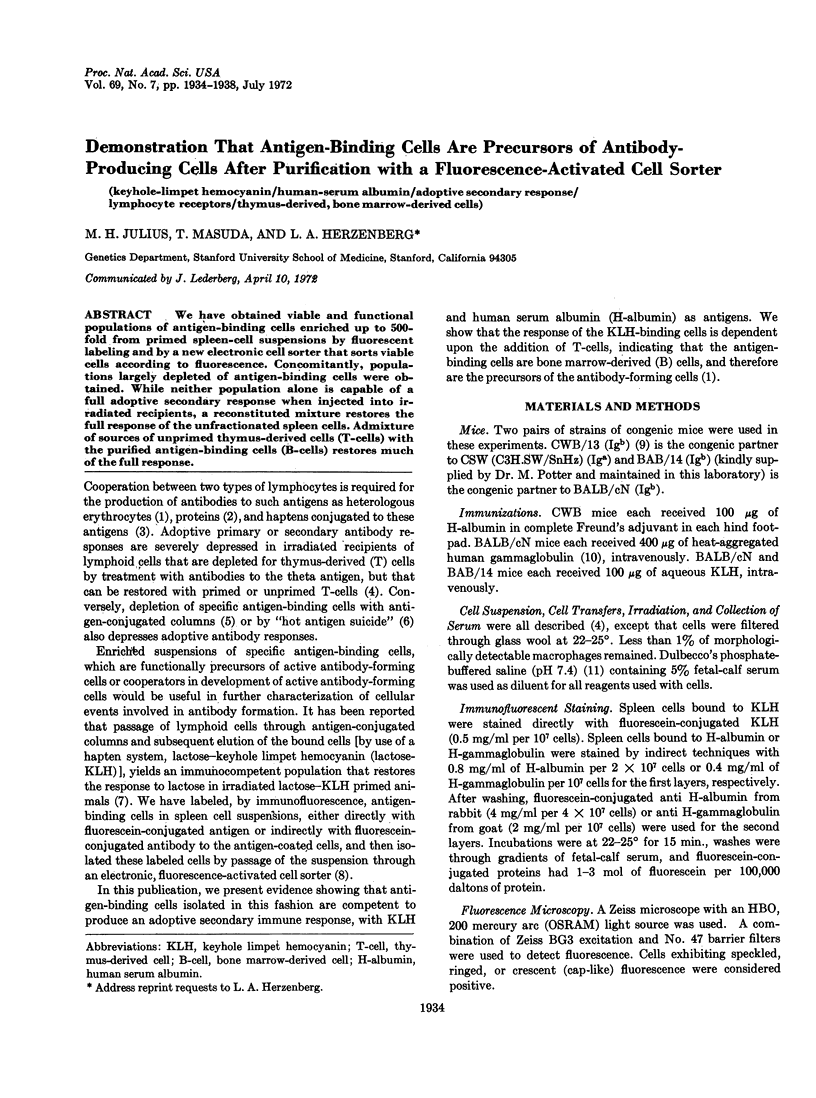
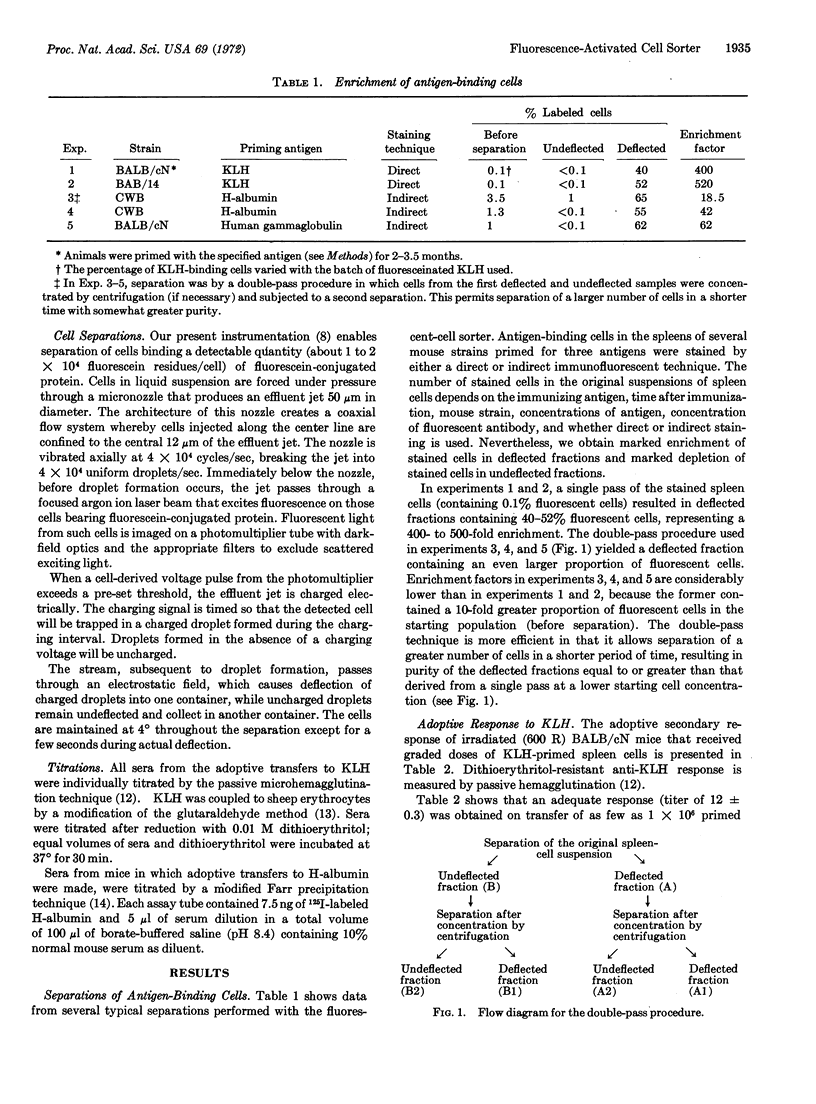
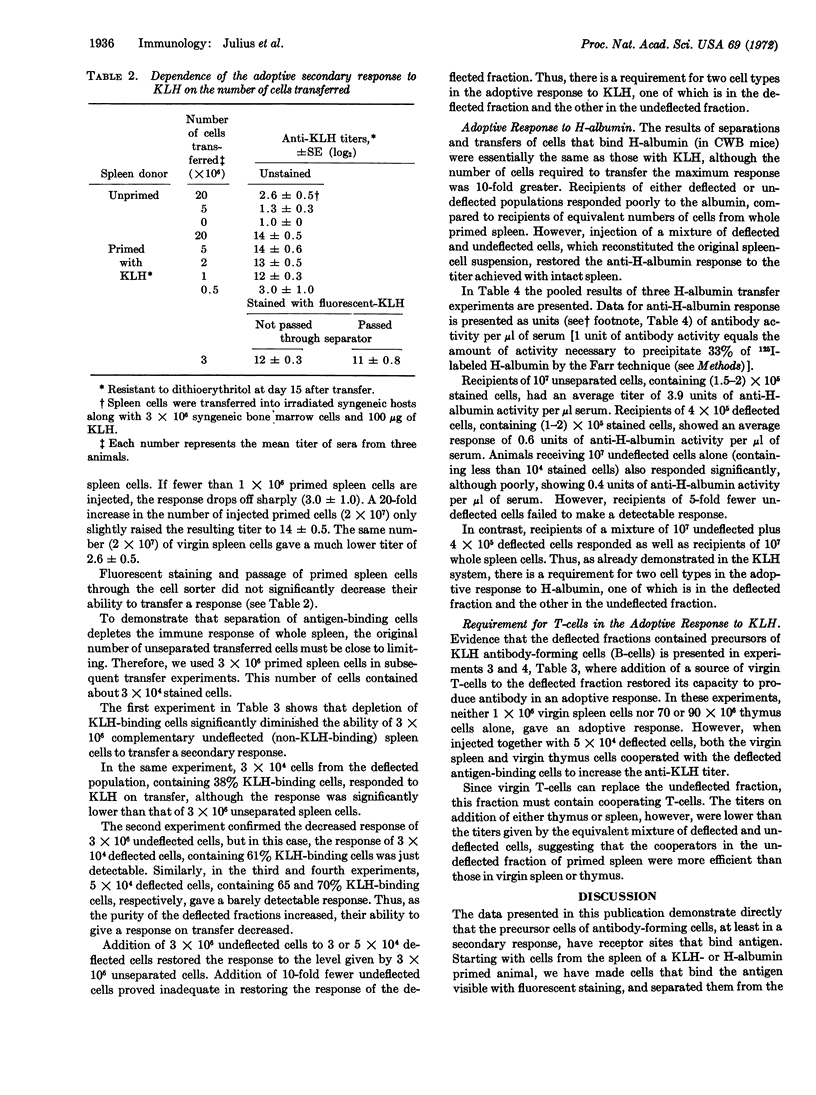
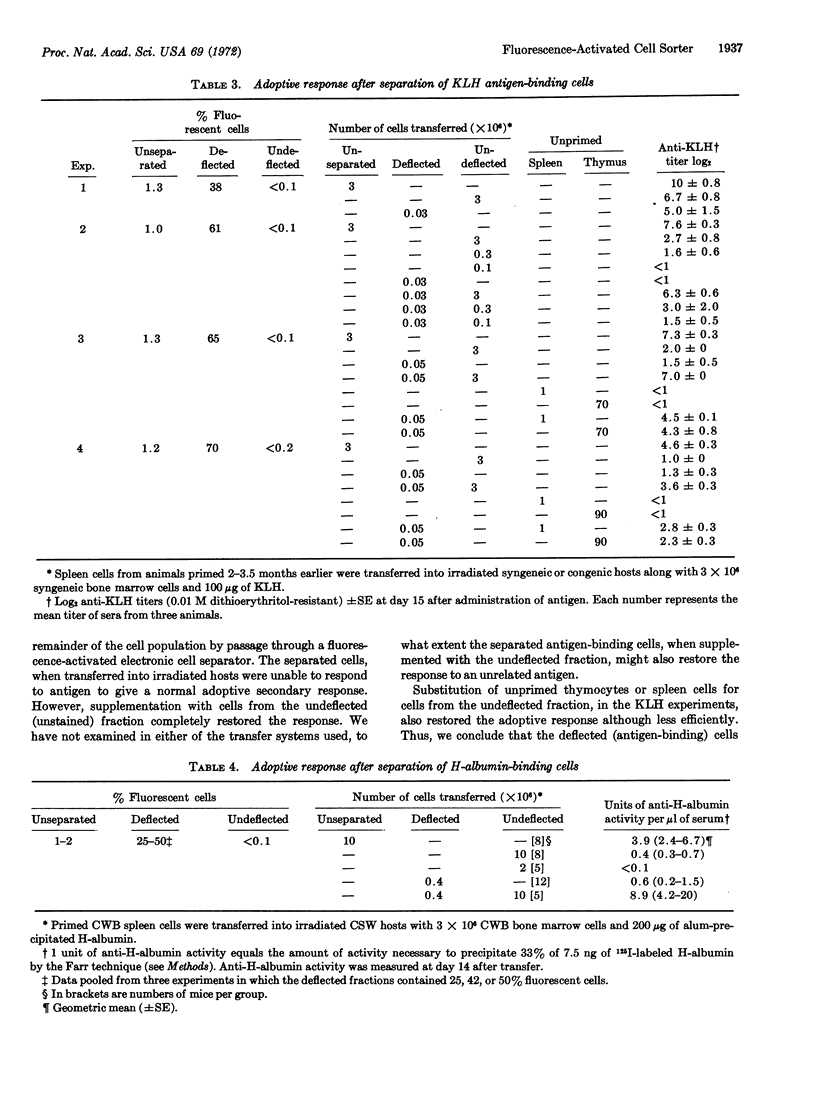
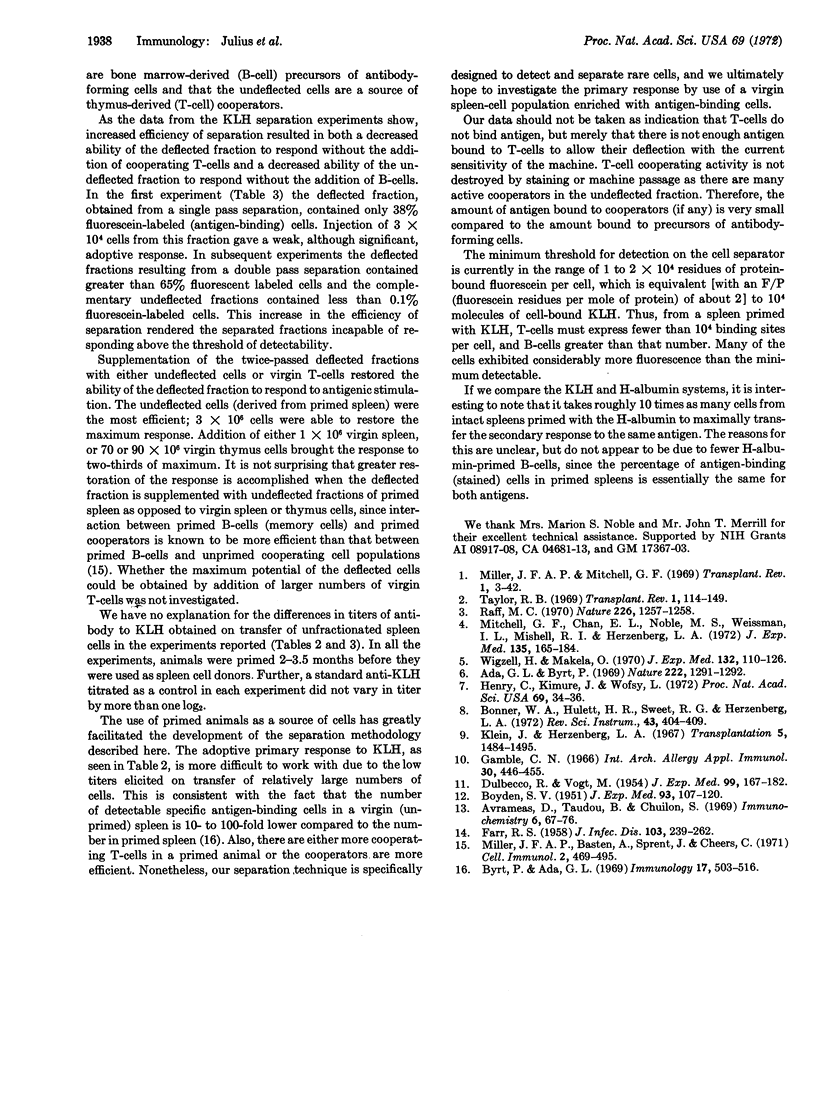
Selected References
These references are in PubMed. This may not be the complete list of references from this article.
- Ada G. L., Byrt P. Specific inactivation of antigen-reactive cells with 125I-labelled antigen. Nature. 1969 Jun 28;222(5200):1291–1292. doi: 10.1038/2221291a0. [DOI] [PubMed] [Google Scholar]
- Avrameas S., Taudou B., Chuilon S. Glutaraldehyde, cyanuric chloride and tetrazotized O-dianisidine as coupling reagents in the passive hemagglutination test. Immunochemistry. 1969 Jan;6(1):67–76. doi: 10.1016/0019-2791(69)90179-7. [DOI] [PubMed] [Google Scholar]
- BOYDEN S. V. The adsorption of proteins on erythrocytes treated with tannic acid and subsequent hemagglutination by antiprotein sera. J Exp Med. 1951 Feb;93(2):107–120. doi: 10.1084/jem.93.2.107. [DOI] [PMC free article] [PubMed] [Google Scholar]
- Bonner W. A., Hulett H. R., Sweet R. G., Herzenberg L. A. Fluorescence activated cell sorting. Rev Sci Instrum. 1972 Mar;43(3):404–409. doi: 10.1063/1.1685647. [DOI] [PubMed] [Google Scholar]
- Byrt P., Ada G. L. An in vitro reaction between labelled flagellin or haemocyanin and lymphocyte-like cells from normal animals. Immunology. 1969 Oct;17(4):503–516. [PMC free article] [PubMed] [Google Scholar]
- DULBECCO R., VOGT M. Plaque formation and isolation of pure lines with poliomyelitis viruses. J Exp Med. 1954 Feb;99(2):167–182. doi: 10.1084/jem.99.2.167. [DOI] [PMC free article] [PubMed] [Google Scholar]
- FARR R. S. A quantitative immunochemical measure of the primary interaction between I BSA and antibody. J Infect Dis. 1958 Nov-Dec;103(3):239–262. doi: 10.1093/infdis/103.3.239. [DOI] [PubMed] [Google Scholar]
- Gamble C. N. The role of soluble aggregates in the primary immune response of mice to human gamma globulin. Int Arch Allergy Appl Immunol. 1966;30(5):446–455. doi: 10.1159/000229829. [DOI] [PubMed] [Google Scholar]
- Henry C., Kimura J., Wofsy L. Cell separation on affinity columns: the isolation of immunospecific precursor cells from unimmunized mice (lactoside hapten-lymphocyte receptors-immunology). Proc Natl Acad Sci U S A. 1972 Jan;69(1):34–36. doi: 10.1073/pnas.69.1.34. [DOI] [PMC free article] [PubMed] [Google Scholar]
- Klein J., Herzenberg L. A. Congenic mouse strains with different immunoglobulin allotypes. I. Breeding scheme, histocompatibility tests, and kinetics of gamma G2a-globulin production by transferred cells for C3H.SW and its congenic partner CWB/5. Transplantation. 1967 Nov;5(6):1484–1495. doi: 10.1097/00007890-196711000-00013. [DOI] [PubMed] [Google Scholar]
- Miller J. F., Basten A., Sprent J., Cheers C. Interaction between lymphocytes in immune responses. Cell Immunol. 1971 Oct;2(5):469–495. doi: 10.1016/0008-8749(71)90057-8. [DOI] [PubMed] [Google Scholar]
- Miller J. F., Mitchell G. F. Thymus and antigen-reactive cells. Transplant Rev. 1969;1:3–42. doi: 10.1111/j.1600-065x.1969.tb00135.x. [DOI] [PubMed] [Google Scholar]
- Mitchell G. F., Chan E. L., Noble M. S., Weissman I. L., Mishell R. I., Herzenberg L. A. Immunological memory in mice. 3. Memory to heterologous erythrocytes in both T cell and B cell populations and requirement for T cells in expression of B cell memory. Evidence using immunoglobulin allotype and mouse alloantigen theta markers with congenic mice. J Exp Med. 1972 Feb 1;135(2):165–184. doi: 10.1084/jem.135.2.165. [DOI] [PMC free article] [PubMed] [Google Scholar]
- Raff M. C. Role of thymus-derived lymphocytes in the secondary humoral immune response in mice. Nature. 1970 Jun 27;226(5252):1257–1258. doi: 10.1038/2261257a0. [DOI] [PubMed] [Google Scholar]
- Taylor R. B. Cellular cooperation in the antibody response of mice to two serum albumins: specific function of thymus cells. Transplant Rev. 1969;1:114–149. doi: 10.1111/j.1600-065x.1969.tb00138.x. [DOI] [PubMed] [Google Scholar]
- Wigzell H., Mäkelä O. Separation of normal and immune lymphoid cells by antigen-coated coated columns. Antigen-binding characteristics of membrane antibodies as analyzed by hapten-protein antigens. J Exp Med. 1970 Jul 1;132(1):110–126. doi: 10.1084/jem.132.1.110. [DOI] [PMC free article] [PubMed] [Google Scholar]


